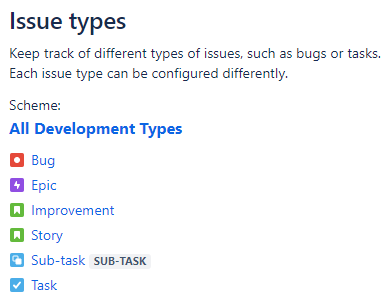If you’re only using Jira issue types to classify different types of work, you’re missing out! In addition to their organization and classification value, issue types provide many additional useful features. Here’s a brief summary of each:
Icon
Icons serve as visual distinguishers in search results, reports, dashboards, boards, and more.
Tip: Make sure each issue type has a unique icon in each issue type scheme.
In the example scheme, both improvement and story have the same icon. I would change improvement so it has a different image and/or color.

Description
Each issue type has a user-facing description. Hover over an issue type’s icon to see it.
Tip: Customize the description field to help users understand the intent of each issue type’s use.

Hierarchy
Issue types create the capability of a parent/child hierarchical relationship. Jira comes with two levels but additional levels can be added with apps or by upgrading to Jira Software Cloud Premium or Enterprise.

Different Settings
And the best part: Issue types allow issues to have different workflows, screens (containing different fields), or both.
For example, a story issue type may have different custom fields or workflow steps than a task issue type in the same Jira project. Issue types and schemes make different procedures and information collection possible.

Read More
Check out my Understanding Jira Issue Types, from Basics to Advanced Hierarchies article on Salto’s website that covers issue type uses, relationships, hierarchy capabilities, and the new “parent” field in Jira Software Cloud.

